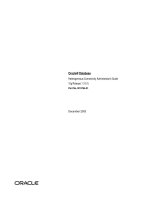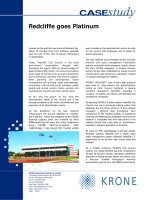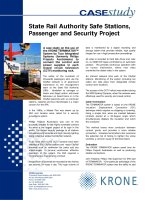Tài liệu Recovery Manager Quick Start Guide pdf
Bạn đang xem bản rút gọn của tài liệu. Xem và tải ngay bản đầy đủ của tài liệu tại đây (88.54 KB, 28 trang )
Oracle® Database
Recovery Manager Quick Start Guide
10g Release 1 (10.1)
December 2003
Part No. B10769-01
Recovery Manager Quick Start Guide has three purposes:
■
To introduce the basic concepts of Oracle backup and recovery, and the
Recovery Manager (RMAN), the tool Oracle recommends that you use
for your backup and recovery
■
To orient you on the rest of the backup and recovery documentation set
■
To serve as a convenient quick reference for the most frequently used
RMAN commands, options and views
This document is organized into the following sections:
■
Overview of Backup and Recovery Documentation Set
■
Overview of the RMAN Environment
■
Starting and Exiting RMAN
■
Configuring Persistent Settings for the RMAN Environment
■
Backing Up Database Files
■
Restoring and Recovering Database Files
■
Reporting on RMAN Operations
■
Managing the RMAN Repository
■
Repetitive Tasks: RMAN and Scripting
■
RMAN Syntax Quick Reference
■
Backup and Recovery Views
■
Documentation Accessibility
Oracle is a registered trademark, and SQL*Plus is a trademark or registered trademark of Oracle Corporation. Other names
may be trademarks of their respective owners.
Copyright 2003 Oracle Corporation.
All Rights Reserved.
2
Conventions for Command Syntax
The following table shows the syntax convention used in this manual.
Convention Meaning
[ ] Brackets enclose one or more optional items. Do not enter the
brackets.
{ }
Braces enclose two or more items, one of which is required. Do not
enter the braces.
|
A vertical bar represents a choice of two or more options within
brackets or braces. Enter one of the options. Do not enter the
vertical bar.
... Horizontal ellipsis points indicate either:
■
That we have omitted parts of the code that are not directly
related to the example
■
That you can repeat a portion of the code
.
.
.
Vertical ellipsis points indicate that we have omitted several lines of
code not directly related to the example.
Other
notation
You must enter symbols other than brackets, braces, vertical bars,
and ellipsis points as shown.
Bold Bold type indicates the introduction of a significant term. Usually a
brief definition or a longer discussion follows the introduction of
the term.
Italics Italicized text indicates placeholders or variables for which you
must supply particular values.
UPPERCASE Uppercase typeface indicates elements supplied by the system. We
show these terms in uppercase in order to distinguish them from
terms you define. Unless terms appear in brackets, enter them in
the order and with the spelling shown. However, because these
terms are not case sensitive, you can enter them in lowercase.
lowercase Lowercase typeface indicates programmatic elements that you
supply. For example, lowercase indicates names of tables, columns,
or files.
Note: Some programmatic elements use a mixture of UPPERCASE
and lowercase. Enter these elements as shown.
3
Overview of Backup and Recovery Documentation Set
Besides this quick start guide, there are three volumes in the backup and
recovery documentation set.
■
Oracle Database Backup and Recovery Basics explains the concepts of
backup and recovery and the most common techniques for using
RMAN for backup, recovery and reporting in more detail, as well as
providing more information on how to plan a backup and recovery
strategy.
■
Oracle Database Backup and Recovery Advanced User's Guide presents
in-depth information on RMAN architecture, backup and recovery
concepts and mechanisms, advanced recovery techniques such as
point-in-time recovery and database flashback features, and backup
and recovery performance tuning. It also covers user-managed backup
and recovery, using host operating system facilities instead of RMAN.
This volume is essential for backup and recovery of more sophisticated
database deployments, and for advanced recovery scenarios.
■
Oracle Database Recovery Manager Reference provides complete
information on syntax and semantics for all Recovery Manager
commands, and describes the database views available for reporting on
backup and recovery activities.
Overview of the RMAN Environment
Installed with the database, Recovery Manager (RMAN) is an Oracle
database client which performs backup and recovery tasks on your
databases and automates administration of your backup strategies. It
greatly simplifies backing up, restoring, and recovering database files.
The RMAN environment consists of the utilities and databases that play a
role in backing up your data. At a minimum, the environment for RMAN
must include the following:
■
The target database to be backed up
■
The RMAN client, which interprets backup and recovery commands,
directs server sessions to execute those commands, and records your
backup and recovery activity in the target database control file.
Some environments will also use these optional components:
■
A flash recovery area, a disk location in which the database can store
and manage files related to backup and recovery;
■
Media management software, required for RMAN to interface with
backup devices such as tape drives;
■
A recovery catalog database, a separate database schema used to record
RMAN activity against one or more target databases.
4
About the Target Database
The target database is the database that you are backing up, restoring, or
recovering with RMAN.
About the RMAN Client
RMAN is a command-line-oriented database client, much like SQL*Plus,
with its own command syntax. From the RMAN client you can issue
RMAN commands and SQL statements to perform and report on backup
and recovery operations.
RMAN can take interactive input or read input from plain text files (called
command files). RMAN then communicates with one or more server
processes on the target database server which actually perform the work.
You can also access RMAN through the Enterprise Manager; for details see
Oracle Enterprise Manager Administrator's Guide.
The RMAN executable is typically installed in the same directory as the
other database executables. On Unix systems, for example, the RMAN
executable is located in $ORACLE_HOME/bin.
About the RMAN Repository
RMAN maintains metadata about the target database and its backup and
recovery operations in the RMAN repository. Among other things, RMAN
stores information about its own configuration settings, the target database
schema, archived redo logs, and all backup files on disk or tape. RMAN’s
LIST, REPORT, and SHOW commands display RMAN repository
information.
RMAN repository data is always stored in the control file of the target
database. The CONTROL_FILE_RECORD_KEEP_TIME initialization
parameter controls how long backup records are kept in the control file
before those records are re-used to hold information about more recent
backups. The repository can also be kept in a recovery catalog, a separate
database that keeps historical data on backup activities much longer than
the control file and preserves backup information if the control file is lost.
About the Flash Recovery Area
The Automatic Disk-Based Backup and Recovery feature simplifies
managing disk space and files related to backup and recovery, by managing
all backup and recovery related files in a flash recovery area. You set the
flash recovery area size and location, using the DB_RECOVERY_FILE_DEST
and DB_RECOVERY_FILE_DEST_SIZE initialization parameters. You also
specify a retention policy that dictates when backups may be discarded.
RMAN then manages your backup storage, deleting obsolete backups and
backups already copied to tape when space is needed, but keeping as many
5
backups on disk as space permits. This minimizes restores from tape during
data recovery operations to shorten restore and recovery times.
About the Recovery Catalog
In addition to RMAN repository records, the recovery catalog can also hold
RMAN stored scripts, sequences of RMAN commands for common backup
tasks. Centralized storage of scripts in the recovery catalog can be more
convenient than working with command files.
Except for stored scripts, all of RMAN’s features work equally well with or
without a recovery catalog. For more information on the recovery catalog
see Oracle Database Backup and Recovery Advanced User's Guide.
About Media Managers
To access sequential media devices like tape libraries, RMAN uses
third-party media management software. A media manager controls these
devices during backup and recovery, managing the loading, labeling and
unloading of media, among other functions. Oracle Corporation’s Backup
Solutions Program (BSP) works with vendors to help them produce media
management software for their devices. For enterprises that already use
media management software in their enterprise, many of those software
products can be directly integrated with RMAN. Contact your media
management software vendor for details about whether they participate in
the BSP and have an RMAN-compatible media management layer.
Starting and Exiting RMAN
The RMAN client is started by issuing the rman command at the command
prompt of your operating system.
RMAN must connect to a target database (with SYSDBA privileges) to
perform backup and recovery tasks. RMAN can also connect to a recovery
catalog database if you are using one. Specify target and recovery catalog
databases using command line options or using the CONNECT command.
This command connects RMAN to a target database and a recovery catalog:
% rman TARGET / CATALOG cat_usr/pwd@cat_str
Connect to a target database without using a recovery catalog:
% rman TARGET SYS/pwd@target_str
Starting RMAN without connecting to a database
% rman
Once started, RMAN displays an "RMAN>" prompt for your commands.
6
Syntax of Common RMAN Command-line Options
RMAN
[ TARGET [=] connectStringSpec
| { CATALOG [=] connectStringSpec }
| LOG [=] ['] filename ['] [ APPEND ]
.
.
.
]...
connectStringSpec::=
['] [userid] [/ [password]] [@net_service_name] [']
This example appends the output from an RMAN session to a text file at
$ORACLE_HOME/dbs/log/msglog.log
% rman TARGET / LOG $ORACLE_HOME/dbs/log/msglog.log APPEND
To quit the RMAN client, type EXIT at the RMAN prompt:
RMAN> EXIT
Configuring Persistent Settings for the RMAN Environment
You can configure persistent settings in the RMAN environment, which
apply to all subsequent operations, even if you exit and restart RMAN.
Configuring Disk Devices and Channels
RMAN channels are connections to
server sessions on the target database, which are used to perform all
backup, restore and recovery operations. By default, RMAN allocates one
disk channel for all operations. You can configure dditional channels for use
with disks and with other media.
By default, RMAN sends all backups to disk. If a flash recovery area is
configured, it is the default destination; otherwise the default directory is
platform-dependent. If, as recommended, you use the flash recovery area
as the destination for all disk backups, you would set up a flash recovery
area and use the following CONFIGURE command:
RMAN> CONFIGURE CHANNEL DEVICE TYPE DISK FORMAT CLEAR;
The following command configures RMAN to write disk backups to the
/tmp directory:
RMAN> CONFIGURE CHANNEL DEVICE TYPE DISK FORMAT '/tmp/%U';
The format specifier %U is replaced with unique filenames for the files when
you take backups. Refer to Oracle Database Backup and Recovery Advanced
User's Guide. for more details on configuring destinations for your disk
backups.
7
Configuring Tape Devices and Channels
After configuring your media
management software, you can make the media manager the default
destination for RMAN backups:
RMAN> CONFIGURE DEFAULT DEVICE TYPE TO sbt;
Some media managers require a PARMS string to configure device settings:
RMAN> CONFIGURE CHANNEL DEVICE TYPE sbt PARMS=’ENV=mml_env_settings';
Multiple channels can be configured to run backups in parallel. This
command configures two sbt channels for use in RMAN jobs:
RMAN> CONFIGURE DEVICE TYPE sbt PARALLELISM 2;
Configuring a Retention Policy
Retention policy governs how long backup files
are retained. Retention policy can be set in terms of a recovery window
(how far into the past you need to be able to recover your database), or a
redundancy value (how many backups of each file must be retained).
This command ensures that RMAN retains all backups needed to recover
the database to any point in time in the last 7 days:
RMAN> CONFIGURE RETENTION POLICY TO RECOVERY WINDOW OF 7 DAYS;
This command ensures that RMAN retains three backups of each datafile:
RMAN> CONFIGURE RETENTION POLICY TO REDUNDANCY 3;
Use DELETE OBSOLETE to immediately delete backups no longer required
by the retention policy. (For backups stored in a flash recovery area, you do
not need to perform this step. The database automatically deletes obsolete
files and files already backed up to tape when space is needed.) You can use
the KEEP option of the BACKUP and CHANGE commands to override the
configured retention policy for individual backups-- for example, to force
the retention of a specific backup.
Configuring Control File Autobackups
This command configures RMAN to back
up the control file after each backup or copy:
RMAN> CONFIGURE CONTROLFILE AUTOBACKUP ON;
By default, RMAN automatically names control file autobackups and stores
them in the flash recovery area. The following command configures RMAN
to write control file autobackups to the /mybackupdir directory:
RMAN> CONFIGURE CONTROLFILE AUTOBACKUP FORMAT
FOR DEVICE TYPE DISK TO '/mybackupdir/cf%F';
8
The %F element of the format string combines the DBID, day, month, year,
and sequence number to generate a unique filename. %F is required for
control file autobackups.
Restoring Default Values for Configured Settings
Reset any CONFIGURE setting to
its default by running the command with the CLEAR option, as shown here:
RMAN> CONFIGURE CHANNEL DEVICE TYPE sbt CLEAR;
RMAN> CONFIGURE RETENTION POLICY CLEAR;
RMAN> CONFIGURE CONTROLFILE AUTOBACKUP FORMAT FOR DEVICE TYPE DISK
CLEAR;
Viewing Current Settings
This command shows all configurable settings:
RMAN> SHOW ALL;
The output lists the CONFIGURE commands to recreate this configuration.
Backing Up Database Files
Use the BACKUP command to back up files. You will usually configure
default devices and channels in advance; BACKUP backs up your data to the
configured default device and channels for the type of backup requested.
If you specify BACKUP AS COPY, then RMAN copies the files as image
copies, bit-for-bit copies of database files that can only be created on disk.
This command creates image copy backups of all datafiles in the database:
RMAN> BACKUP AS COPY DATABASE;
If you specify BACKUP AS BACKUPSET, then RMAN stores its backups in
backup sets. A backup set consists of one or more backup pieces, physical
files containing the data. A backup set usually contains only one backup
piece. Only RMAN can create and restore backup sets. The following
command creates a backup of the database and archived logs on tape, in
backup set format, using the configured channels:
RMAN> BACKUP DEVICE TYPE sbt DATABASE PLUS ARCHIVELOG;
Backing Up Individual Files
You can back up individual tablespaces, database
files, server parameter files, and backup sets with various options, as in
these examples:
RMAN> BACKUP ARCHIVELOG COMPLETION TIME BETWEEN
’SYSDATE-31’ AND ’SYSDATE-7’;
RMAN> BACKUP TABLESPACE system, users, tools;
RMAN> BACKUP AS BACKUPSET DATAFILE
’ORACLE_HOME/oradata/trgt/users01.dbf’,
’ORACLE_HOME/oradata/trgt/tools01.dbf’;
RMAN> BACKUP CURRENT CONTROLFILE TO ’/backup/curr_cf.copy’;
9
RMAN> BACKUP SPFILE;
RMAN> BACKUP BACKUPSET ALL;
Note that in the above examples you should enter the path to your Oracle
home in place of "
ORACLE_HOME
".
Backup Options
Here are some often-used BACKUP command options:
The following BACKUP commands illustrate these options:
RMAN> BACKUP FORMAT='AL_%d/%t/%s/%p' ARCHIVELOG LIKE ’%arc_dest%’;
RMAN> BACKUP TAG ’weekly_full_db_bkup’ DATABASE MAXSETSIZE 10M;
RMAN> BACKUP COPIES 2 DEVICE TYPE sbt BACKUPSET ALL;
Incremental Backups
If you specify BACKUP INCREMENTAL, RMAN will
create incremental backups of your database. Incremental backups capture
on a block-by-block basis changes in your database since a previous
incremental backup. The starting point for an incremental backup strategy
is a level 0 incremental backup, which backs up all blocks in the database.
Level 1 incremental backups, taken at regular intervals, contain only
changed blocks since a previous incremental backup. These can be
cumulative (including all blocks changed since the most recent level 0
backup) or differential (including only blocks changed since the most
recent incremental backup, whether it is level 0 or level 1).
Incremental backups are generally smaller and faster to create than full
database backups. Recovery from an incremental backup is faster than
recovery using redo logs alone. During a restore from incremental backup,
the level 0 backup is used as the starting point, then changed blocks are
updated based on level 1 backups where possible to avoid re-applying
changes from redo one at a time. Recovering with incremental backups
requires no additional effort on your part. If incremental backups are
available, RMAN will use them during recovery.
RMAN’s incrementally updated backups feature allows for a more
efficient incremental backup routine. Changes from level 1 backups can be
used to roll forward an image copy level 0 incremental backup, so that it
Parameter Example Explanation
FORMAT FORMAT ’/tmp/%U’ Specifies a location and name for
backup pieces and copies. You must
use substitution variables to generate
unique filenames.
TAG TAG ’monday_bak’ Specifies a user-defined string as a
label for the backup. If you do not
specify a tag, then RMAN assigns a
default tag with the date and time.
10
includes all changes as of the SCN at which the level 1 incremental backup
was created. Recovery using the updated level 0 incremental backup is
faster, because all changes from the level 1 incremental backup have already
been applied.
See Oracle Database Backup and Recovery Basics for more details and examples
for incremental backups and incrementally updated backups.
Validating Backups
You can run a test RMAN backup that does not generate
any output. Validation confirms that a backup could be run, by confirming
that all database files exist, are in their correct location, and are free of
physical and logical corruption. For example:
RMAN> BACKUP VALIDATE DATABASE ARCHIVELOG ALL;
Restoring and Recovering Database Files
Use the RESTORE and RECOVER commands for RMAN restore and recovery
of physical database files. Restoring datafiles is retrieving them from
backups as needed for a recovery operation. Recovery is the application of
changes from redo logs and incremental backups to a restored datafile, to
bring the datafile to a desired SCN or point in time.
Recovering the Whole Database
Use the RESTORE DATABASE and RECOVER
DATABASE commands on the whole database. For example:
RMAN> STARTUP FORCE MOUNT;
RMAN> RESTORE DATABASE;
RMAN> RECOVER DATABASE;
RMAN> ALTER DATABASE OPEN;
Note that the database must not be open when restoring or recovering the
entire database.
Recovering Current Tablespaces
Use the RESTORE TABLESPACE and RECOVER
TABLESPACE commands on individual tablespaces when the database is
open. Take the tablespace that needs recovery offline, restore and then
recover the tablespace, and bring the recovered tablespace online. The
following steps recover the users tablespace:
RMAN> SQL 'ALTER TABLESPACE users OFFLINE';
RMAN> RESTORE TABLESPACE users;
RMAN> RECOVER TABLESPACE users;
RMAN> SQL 'ALTER TABLESPACE users ONLINE';
Recovering Current Datafiles
Use the RESTORE DATAFILE and RECOVER
DATAFILE commands on individual current datafiles when the database is
open. Take the datafile that needs recovery offline, restore and recover the
11
datafile, and bring the datafile online. For example, to restore and recover
datafile 7:
RMAN> SQL 'ALTER DATABASE DATAFILE 7 OFFLINE';
RMAN> RESTORE DATAFILE 7;
RMAN> RECOVER DATAFILE 7;
RMAN> SQL 'ALTER DATABASE DATAFILE 7 ONLINE';
Recovering Individual Data Blocks
RMAN can recover individual corrupted
datafile blocks. When RMAN performs a complete scan of a file for a
backup, any corrupted blocks are listed in V$DATABASE_BLOCK_
CORRUPTION. Corruption is usually reported in alert logs, trace files or
results of SQL queries. Use BLOCKRECOVER to repair all corrupted blocks:
RMAN> BLOCKRECOVER CORRUPTION LIST;
You can also recover individual blocks, as shown in this example:
RMAN> BLOCKRECOVER DATAFILE 7 BLOCK 233, 235 DATAFILE 4 BLOCK 101;
Validating Restores
You can run a RESTORE... VALIDATE operation to
confirm that a restore operation can be performed successfully. RMAN
decides which backup sets, datafile copies, and archived logs are needed for
the operation, and scans them to verify that they are usable. For example:
RMAN> RESTORE DATABASE VALIDATE;
Reporting on RMAN Operations
The RMAN LIST and REPORT commands, generate reports on backup
activities based on the RMAN repository. Use SHOW ALL to display the
current RMAN configuration. You can also query the views described in
"Backup and Recovery Views" on page 25.
Listing Backups
Run the LIST BACKUP and LIST COPY commands to
display information about backups and datafile copies listed in the
repository. You can display specific objects, as in the following examples:
RMAN> LIST BACKUP OF DATABASE;
RMAN> LIST COPY OF DATAFILE 1, 2, 3;
RMAN> LIST BACKUP OF ARCHIVELOG FROM SEQUENCE 1437;
RMAN> LIST CONTROLFILECOPY "/tmp/cf.cpy";
RMAN> LIST BACKUPSET OF DATAFILE 1;
For backups, you can control the format of LIST output with these options:
Parameter Example Explanation
BY BACKUP LIST BACKUP OF
DATABASE BY BACKUP
Organizes the output by backup set.
This is the default mode of presentation.









